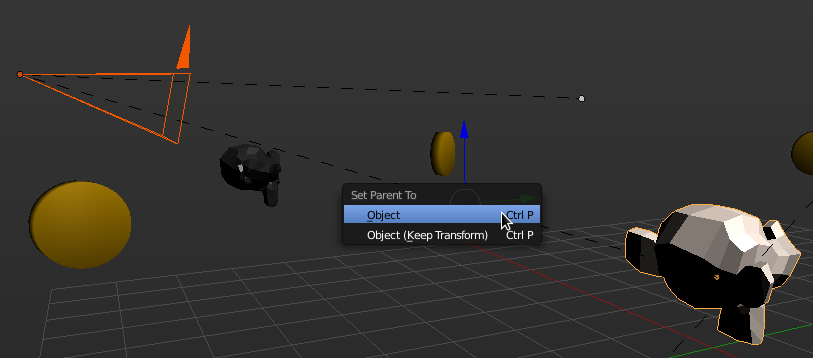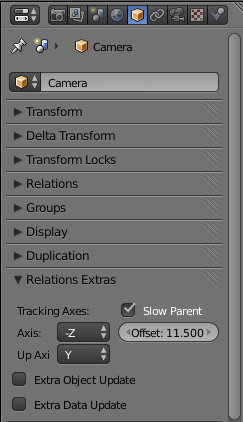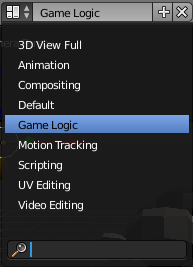Object Oriented¶
Objectives¶
 |
In this part you learn how to write a little game for the game engine which is splitted in many scripts, which are executed every frame. |
Running scripts for an object¶
If you want to run a script for a Blender-Object, you can use the logic bricks to do that. First you have to add an »Always« sensor. Click to the left ‘’‘, for executing the script every frame.

Then add an »Python« controller and set the Script Property to your script.

Then connect them.
The scripts¶
The script for our Player (The monkey named »Player«).
#! bpy
import bge
import timeit
import aud
import os
def main():
"""Contains all changes"""
# get scene
scene = bge.logic.getCurrentScene()
# get contoller
con = bge.logic.getCurrentController()
# get player
player = con.owner
# get keyboard
keyboard = bge.logic.keyboard
# get the text object
text = scene.objects["Text"]
# check if start has already been run
if "lives" not in player:
start(player)
# check for collisions
for object in scene.objects:
# does object collide
# the distance is from origin to origin, so we subtract a bit
if player.getDistanceTo(object) - 2 <= 0:
# Is object an enemy ...
if object.name.startswith("Enemy"):
if player["can_collide"]:
player["lives"] -= 1
# play enemy hit sound
aud.device().play(player["enemy_sound"])
# Set that player can't collide
player["can_collide"] = False
# register time of collision
player["last_col"] = timeit.default_timer()
# ... or is object a coin?
elif object.name.startswith("Coin"):
player["coins"] += 1
# play collecting sound with the aud module
aud.device().play(player["coin_sound"])
# remove the coin from the scene
object.endObject()
# player hasn't got lives?
if player["lives"] <= 0:
print("lost")
# remove player from scene
player.endObject()
# stop game
bge.logic.endGame()
# player got all coins?
if player["coins"] >= 10:
print("Win")
bge.logic.endGame()
# player can collide again?
if not player["can_collide"]:
if (timeit.default_timer() - player["last_col"]) >= 1:
player["can_collide"] = True
# move player
# keyboard events
k_events = bge.logic.KX_INPUT_ACTIVE
# up arrow pressed?
if keyboard.events[bge.events.UPARROWKEY] == k_events:
# move player forwards on its local y axis
player.applyMovement((0, 0, .2), True)
# down arrow pressed
if keyboard.events[bge.events.DOWNARROWKEY] == k_events:
# move player backwards on its local y axis
player.applyMovement((0, 0, -.2), True)
# left arrow pressed
if keyboard.events[bge.events.LEFTARROWKEY] == k_events:
# rotate to the left
player.applyRotation((0, 0, .05))
# right arrow pressed
if keyboard.events[bge.events.RIGHTARROWKEY] == k_events:
# rotate to the right
player.applyRotation((0, 0, -.05))
# Set the text
text.text = "Lives: {}; Coins: {}".format(player["lives"], player["coins"])
def start(player):
"""Setup the player"""
player["lives"] = 3
player["coins"] = 0
player["can_collide"] = True
# sound with the aud module
# coin collect sound
path = bge.logic.expandPath("//snd/coin.wav")
player["coin_sound"] = aud.Factory.file(path)
# enemy hit sound
path = bge.logic.expandPath("//snd/enemy.wav")
player["enemy_sound"] = aud.Factory.file(path)
main()
And the Script for our Enemys:
#! bpy
import bge
from random import randint
def main():
"""Contains all changes"""
# get scene
scene = bge.logic.getCurrentScene()
# get contoller
con = bge.logic.getCurrentController()
# get player
enemy = con.owner
# check, if enemy is outside the field
if abs(enemy.position[0]) >= 20 or abs(enemy.position[1]) >= 20:
# reverse direction
enemy.applyRotation((0, 0, 180))
# change direction in ca. 1% of the calls
if randint(1, 100) == 1:
# change direction
enemy.applyRotation((0, 0, randint(1, 360)))
# check for collisions
for object in scene.objects:
# does object collide
# the distance is from origin to origin, so we subtract a bit
if enemy.getDistanceTo(object) - 2 <= 0 and object != enemy:
# Is object an enemy ...
if object.name.startswith("Enemy"):
# reverse direction
enemy.applyRotation((0, 0, 180))
# move
enemy.applyMovement((0, 0, .15), True)
main()
The camera¶
Connecting the camera to the player: 1. Deselect all (»A« toggles selection) 2. Select the camera (with a right click) 3. Press shift while selecting the player, so you selected both and the player is active 4. Press »Ctrl« + »P« and click on »Object«

- Select the camera again and enable »Slow Parent« in the Relations Extras
- Set the Offset to »11.5«

More about Blender and the Game Enigne under Blender Game Engine – API


